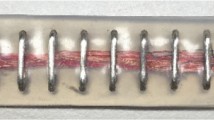Abstract
A surface electromyogram (EMG) is recorded based on the interference of the action potentials produced by certain motor units of a muscle. If the composition of the interference wave can be analyzed, the mechanisms of the muscle contraction can be elucidated in greater detail. Previously, we proposed a multi-channel method based on extraction of all of the conducting waves existing in a surface EMG, and examined the characteristics of each conducting wave. As a result, it became possible to consider the detailed mechanisms of muscle contraction. In the previous research, the triceps surae muscle was used as the test muscle using an arcuate electrode, and the obtained conducting wave can be extracted, but it is difficult to estimate the muscle fiber direction. To solve this problem, we proposed a new electrode. The feature of this is that four sterling silver wires with a diameter of 1 mm, a length of 10, 9, 8, 7, and 6 mm are arranged in multiple directions. In this study, the measurement was performed using the m-ch method and the proposed electrode, and the difference in the characteristics of the conducted wave obtained depending on the electrode width and direction was considered. In the experiment, the test muscles were the biceps brachii muscle and the triceps surae muscle, and a constant load was applied and maintained for 10 s to acquire myoelectric potential data. The experiment was performed in 3 patterns. As a results, it is possible to estimate the muscle fiber direction from the conducting waves obtained in each row for both the biceps brachii muscle and the triceps surae muscle. In the future, we will change the attachment position of the triceps surae muscle and examine the electrode shape, and this is a guideline to verify whether measurement is possible regardless of the test muscle.
Access this chapter
Tax calculation will be finalised at checkout
Purchases are for personal use only
Similar content being viewed by others
References
Kosuge, T., Itakura, N., Mito, K.: Conducting waves using multi-channel surface EMG. IEEJ Trans. C134(3), 390–397 (2014)
Maeda, M., Itakura, N., Mizuno, T.: Conduction wave analysis on arcuate electrodes using multi-channel surface EMG. University of Electro-Communications Bachelor thesis (2021)
Author information
Authors and Affiliations
Corresponding author
Editor information
Editors and Affiliations
Rights and permissions
Copyright information
© 2022 The Author(s), under exclusive license to Springer Nature Switzerland AG
About this paper
Cite this paper
Okura, K., Matsumoto, Y., Mito, K., Mizuno, T., Itakura, N. (2022). Analysis of Conducting Waves Using Multi-channel Surface Electromyogram Depends on Electrodes Supported Multiple Directions. In: Stephanidis, C., Antona, M., Ntoa, S. (eds) HCI International 2022 Posters. HCII 2022. Communications in Computer and Information Science, vol 1581. Springer, Cham. https://doi.org/10.1007/978-3-031-06388-6_41
Download citation
DOI: https://doi.org/10.1007/978-3-031-06388-6_41
Published:
Publisher Name: Springer, Cham
Print ISBN: 978-3-031-06387-9
Online ISBN: 978-3-031-06388-6
eBook Packages: Computer ScienceComputer Science (R0)




